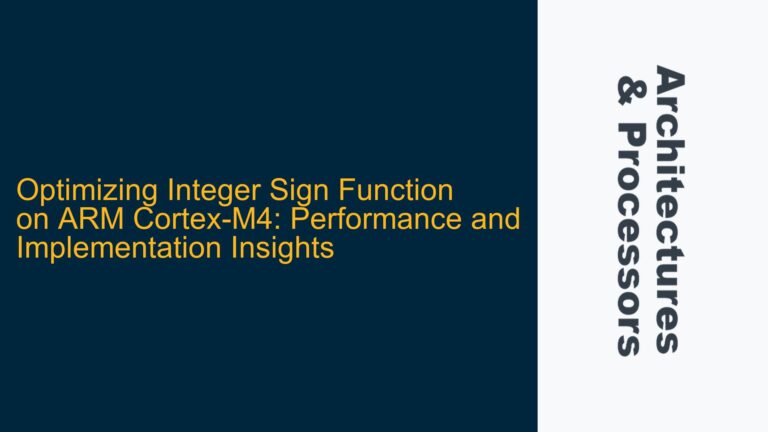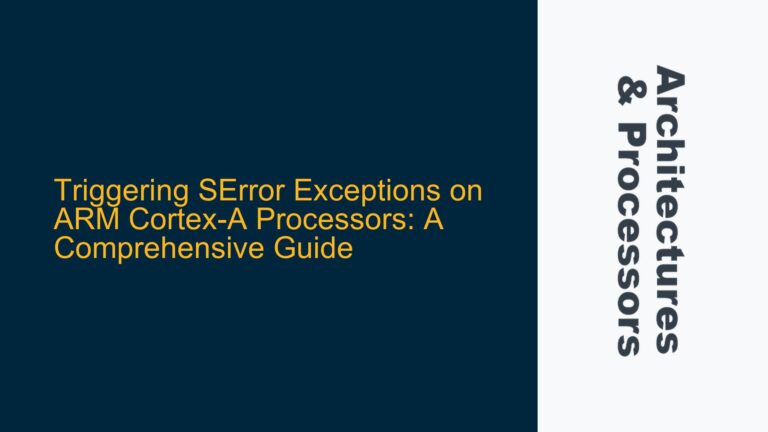ARM Cortex-A78 Instruction Fetch and Decode Pipeline Mechanics
The ARM Cortex-A78 is a high-performance processor core designed for efficiency and scalability, commonly used in mobile and embedded systems. One of the key aspects of its performance is the instruction fetch and decode pipeline, which involves the conversion of assembly instructions into Macro-Operations (MOPs) and further into Micro-Operations (UOPs). Understanding this pipeline is critical for optimizing software and diagnosing performance bottlenecks.
The instruction fetch unit (IFU) in the Cortex-A78 is responsible for fetching instructions from the L1 instruction cache (I-cache). The L1 I-cache has a cache line size of 64 bytes, but the fetch rate is 16 bytes per cycle. This discrepancy arises because the fetch unit is designed to handle a smaller chunk of data per cycle, allowing for more granular control over instruction flow and reducing the complexity of the fetch logic. The fetched instructions are then passed to the decode stage, where they are converted into MOPs.
MOPs are an intermediate representation of instructions that the processor uses internally. They are generated during the decode stage and are closer to the actual operations that the processor will execute. For example, a single ARM instruction like LDR R0, [R1] (load register R0 with the value at the memory address in R1) might be decoded into one or more MOPs, depending on the complexity of the instruction and the specific implementation of the Cortex-A78.
The Cortex-A78 can fetch up to 4 instructions per cycle and decode them into up to 6 MOPs. This means that the decode stage is capable of handling more MOPs than the number of instructions fetched, which is a design choice to improve throughput and handle complex instructions efficiently. The MOPs are then stored in a MOP cache, which serves as a buffer for the pipeline, ensuring a steady flow of operations to the execution units.
MOPs and UOPs: Decoding and Execution Pipeline Breakdown
The distinction between MOPs and UOPs is crucial for understanding how the Cortex-A78 processes instructions. MOPs are the result of the initial decode stage, where assembly instructions are broken down into simpler, internal operations. These MOPs are still relatively high-level and may need further decomposition into UOPs before they can be executed by the processor’s functional units.
UOPs, or Micro-Operations, are the lowest-level operations that the processor executes. They are generated from MOPs further down the pipeline, typically after the decode stage. For example, a store instruction like STR R0, [R1] (store the value in R0 at the memory address in R1) might be split into two UOPs: one for calculating the memory address and another for performing the actual store operation. This splitting allows the processor to handle complex instructions more efficiently by breaking them down into smaller, more manageable tasks.
The Cortex-A78’s pipeline is designed to handle multiple UOPs in parallel, which is essential for achieving high performance. The processor can dispatch multiple UOPs to different execution units simultaneously, allowing it to execute several operations in a single cycle. This parallelism is a key feature of modern high-performance processors and is one of the reasons why the Cortex-A78 is capable of delivering such high throughput.
The generation of UOPs from MOPs is a critical part of the pipeline and can have a significant impact on performance. If the decode stage generates too many UOPs from a single MOP, it can create a bottleneck in the pipeline, reducing overall throughput. Conversely, if the decode stage generates too few UOPs, the processor may not be able to fully utilize its execution units, leading to underutilization and reduced performance.
Cache Line Size, Fetch Rate, and Pipeline Efficiency
The Cortex-A78’s L1 instruction cache has a cache line size of 64 bytes, but the fetch rate is 16 bytes per cycle. This design choice is influenced by several factors, including the need to balance fetch bandwidth with pipeline efficiency and power consumption. Fetching 16 bytes per cycle allows the processor to maintain a steady flow of instructions to the decode stage without overwhelming the pipeline or consuming excessive power.
The 64-byte cache line size is a common choice in modern processors because it strikes a balance between cache efficiency and memory bandwidth. Larger cache lines can reduce the number of cache misses by fetching more data at once, but they also increase the amount of data that needs to be transferred when a cache miss occurs. The 64-byte size is large enough to capture a significant number of instructions in a single fetch, but small enough to minimize the overhead of cache misses.
The fetch rate of 16 bytes per cycle is determined by the design of the fetch unit and the overall pipeline architecture. Fetching 16 bytes per cycle allows the processor to keep up with the decode stage, which can handle up to 6 MOPs per cycle. This ensures that the pipeline remains full and that the processor can maintain high throughput without stalling due to a lack of instructions.
The relationship between cache line size and fetch rate is also influenced by the need to maintain coherency across different systems. Many ARM processors, including the Cortex-A53, Cortex-A57, and Cortex-A73, use a 64-byte cache line size. This consistency makes it easier to implement cache coherency protocols across different processors and ensures that software can be more easily ported between systems without requiring significant changes to cache-related code.
In summary, the Cortex-A78’s instruction fetch and decode pipeline is a complex system designed to maximize performance and efficiency. The conversion of instructions into MOPs and UOPs, the handling of cache lines, and the fetch rate are all carefully balanced to ensure that the processor can execute instructions as quickly and efficiently as possible. Understanding these mechanics is essential for optimizing software and diagnosing performance issues on the Cortex-A78 and other ARM processors.






